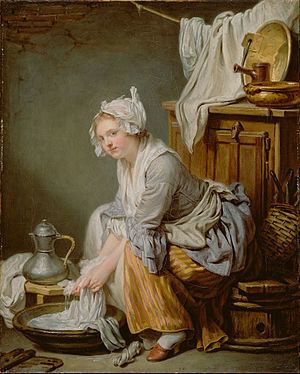Year 1761 | Created 1761 | |
 | ||
Dimensions 40.6 cm × 33 cm (16.0 in × 13 in) Similar The Punished Son, L'Accordée de Village, La Malédiction paternelle, The House of Cards, The Morning Toilet | ||
The laundress jean baptiste greuze
The Laundress (French: La Blanchisseuse) is a 1761 genre painting by French artist Jean-Baptiste Greuze (1725-1805). Its development was influenced by Dutch cabinet painting and the imagery of the laundress made popular through a literary style known as genre poissard. The Laundress was one of fourteen works exhibited by Greuze at the Salon of 1761 and was part of the collection of Greuze's patron, Ange Laurent Lalive de Jully. The painting was mostly unknown for more than two centuries as it was privately held by various Swedish art collectors and rarely seen until it was acquired by the Getty Museum in 1983.
Contents
- The laundress jean baptiste greuze
- Gely korzhev the deserter the laundress
- Background
- Development and exhibition
- Description
- Provenance
- References
Gely korzhev the deserter the laundress
Background
French artist Jean-Baptiste Greuze was a late eighteenth century genre painter who was influenced by seventeenth century Dutch and Flemish artists. He first exhibited at the Salon of 1755, receiving great attention for his genre painting Un Père de famille qui lit la Bible à ses enfàns (Father Reading the Bible to His Children). Several years previously, Denis Diderot began publishing the first modern form of art criticism, and became one of Greuze's admirers after they met in 1759. Greuze achieved even greater success at the Salon of 1761 with L'Accordée de village. Greuze was considered one of the greatest painters of his time, but his popularity began to decline by the 1780s. After the French Revolution he lost everything and died penniless. Greuze was virtually forgotten by the art world for several centuries until his reemergence in the late twentieth century with the reappraisal of art from the Ancien Régime.
Development and exhibition
Greuze likely began working on The Laundress sometime in July 1761, around the same time as L'Accordée de village. In drawing upon Dutch and Flemish cabinet paintings, Greuze may have found inspiration in the style of Rembrandt, and other artists and paintings such as Jean-Baptiste-Siméon Chardin's The Kitchen Maid (1638), Gerrit Dou's Girl Chopping Onions (1646), Gabriël Metsu's The Laundress (1650), and Jan Steen's Girl Offering Oysters (1658-1660).
Greuze exhibited a total of fourteen paintings at the Salon in September 1761, including The Laundress and L'Accordée de village.
Description
A young maidservant bends over to wring out linen with her hands as she stares provocatively at the viewer with a sensual, flirting glance. She appears unkempt, wearing clothes which cover her body and red mules on her feet, but her ankle and foot are exposed suggesting a lack of sexual restraint. A marabout, a kettle used for boiling water, is seated on a small table in the lower left frame.
Provenance
Greuze's patron, Ange-Laurent de La Live de Jully, was the original owner of the painting. After he sold it in 1770, it passed through multiple Swedish collections for several centuries, including those of Count Gustaf Adolph Sparre, Countess Amelie (Ramel) Sparre, Count Gustaf Adolf Frederik de la Gardie, Count Jakob Gustaf de la Gardie, Count Carl de Geer, Countess Elizabeth (von Platen) Wachtmeister, Count Gustav Axel Wachtmeister, and then finally the Wachtmeister Family, who sold it to the J. Paul Getty Museum in 1983.
